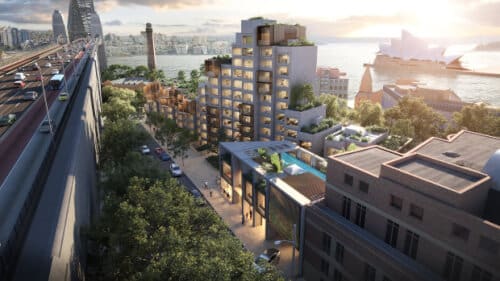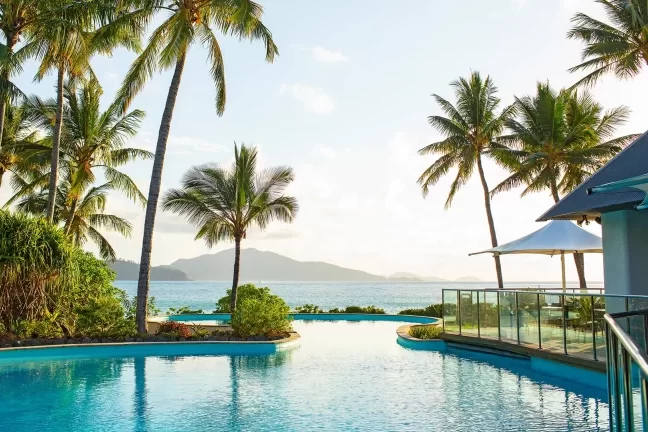The boxy, brutalist Sirius building is about to be transformed from a pragmatic, utilitarian ugly duckling to a swan worthy of a ballet at the Sydney Opera House, over which it looks.
Ads for expressions of interest in new apartments in the redeveloped and expanded block – with one-bedders projected to go for around $1.7 million each – have raised hackles among the campaigners who tried to save the original Sirius, not only from demolition, but from gentrification.
Built more than 40 years ago as homes for housing commission tenants evicted by developments at the nearby Rocks, the edict was that the government wanted something fast, cheap and functional.
What they got was a 3-D bar graph of concrete boxes, with communal areas and accessible roof gardens … and among the best views in Australia.
When JDH Capital, bought it for $150 million in 2019, the focus changed to refashioning it to something more likely to exploit its multi-million-dollar prime position and unmatchable views.
Slideshow of Sirius proposals
And what irked many would-be Sirius-savers, was that they felt the advertising implied that the previous Housing Commission tenants weren’t worthy of either the proposed luxury or the iconic vista, turning the former “carbuncle” on Sydney’s Circular Quay to a “stain” on the city’s history.
According to this story in The Guardian online, an ad in the Australian Financial Review said the former social housing block had been “reimagined for a modern sensibility, with a level of luxury its harbourfront address deserves”.
“Quickly your mind says: did people not deserve it previously?” Ben Peake, an architect and the manager of the Save Our Sirius campaign, told The Guardian. “It feels gross because it is stained with what we have done to the people who lived there.
“We kicked out a 92-year old blind woman and turned her apartment into a multimillion-dollar house. And the government squeezed her into a house she couldn’t properly access.”
To be fair, any prospect of retaining the Sirius as social housing was unlikely to succeed. Some observers say we should probably be grateful that it hasn’t been replaced by another Barangaroo tower.
Early in the sale or scrap debate, a plan by the original architect Tao Gofers to add scallop balconies to the frontage was dismissed, as was an application to give the building heritage listing. However, City of Sydney Lord Mayor Clover Moore stepped in to prevent the building’s demolition.
Nevertheless, the proposed transformation of the Sirius will be profound and absolute, with its genesis as basic accommodation for the lower-paid probably forgotten as it emerges as a shining example of the power of the property dollar.
Gone will be the dirty brown-grey concrete façade – Tao Gofers wanted the block to be white but that was rejected by the then government as being too costly – and copper-clad “pods” will extend the floor space of the individual apartments, some of which will acquire balconies.
According to a story in News Limited, internal walls will be ripped out to build 76 new apartments from the original 79 units and there will be a marble reception area.
Roof areas will feature gardens, and infinity pools with Opera House views will grace at least some of the seven penthouse apartments expected to go on the market for $12 million.
“It has so many attributes – fantastic views, looking right at the Harbour Bridge, the Opera House, the city and out to the Heads,” JDH Capital’s development director John Green told The Australian.
“It was also long and slim, so I knew once we had arranged the apartments internally we could get front and back crossflow apartments – it is rare to have windows on both sides.”
According to the Architecture.com website, the existing building is 11 storeys high in the centre and drops to two storeys at the ends. It contains 79 apartments (28 studios or one-bedroom, 38 two-bedroom, 8 three-bedroom, and 5 four-bedroom), communal spaces, rooftop gardens and underground parking for around 70 cars.
The $150 million spent by JDH Capital on buying the block was intended, the NSW Government said, to be spent on social housing elsewhere in the city.
The new plans, which some sources say will cost another $150 million to realise, include the addition of a few matching pods but the building will retain much of its bar graph shape and can’t go above the height of the Cahill Expressway.
Perhaps that $300 million bar graph, just along from the dock were the Ruby Princess cruise ship brought so many Covid-19 infections to Australia, will serve as a permanent reminder of our collective battle to beat the virus and emerge relatively unscathed.
Potential purchasers can register their interest HERE.










